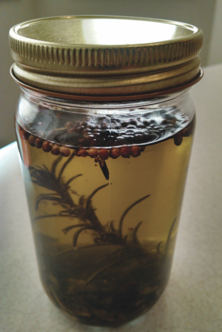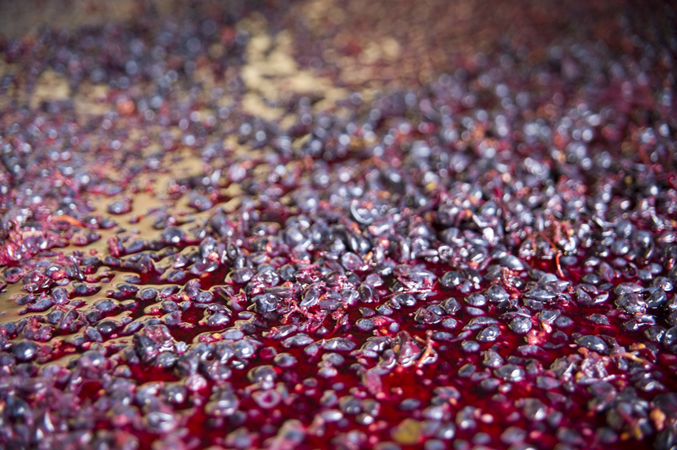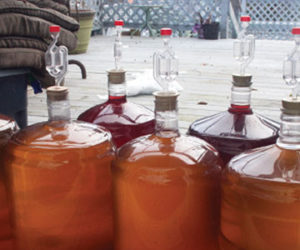
While it is possible to make wine from grapes without adding anything else, in practice that is rarely attempted. Indeed, home winemakers have available to them a wide choice of products to enhance wine quality and improve the outcome. We add yeast, nutrients, enzymes, tannins, sulfites, and other additives and “processing aids,” and we add direct flavoring with oak barrels, staves, sticks, cubes, or powder. All of these are conventional additives and are also recognized as legal additions for commercial wines.
But what about less conventional additions? There are endless possibilities among extracts, flavorings, herbs, and spices when you make a home wine. There are even commercial wines that use a number of these products. In the U.S., the regulations of the Tax and Trade Bureau recognize a category called “special natural wine” that is defined as having a base of natural wine that undergoes “the addition before, during, or after fermentation, of natural herbs, spices, fruit juices, aromatics, essences, and other natural flavorings.” Wines made under these regulations include venerable names such as Thunderbird and Spanada, as well as newer entries with descriptions like Peach Chardonnay and Blackberry Merlot. More traditionally, apéritif wines of European origin have long used a variety of herbs and spices in their production. This group includes both dry (French) and sweet (Italian) vermouth. There are proprietary brands like Dubonnet and Lillet. Dubonnet was first produced as a vehicle for herb additions: It was introduced in 1846 by Joseph Dubonnet in response to a competition organized by the French government. The authorities were looking for a way to get French Foreign Legionnaires to consume more quinine in the fight against malaria! Lillet also represents a source of quinine with cinchona bark (a natural quinine source) among its flavorings. It is also infused with various citrus peels and is fortified with distilled alcohol, starting from a base of Bordeaux wine (Sémillon for the white and rosé versions, and Merlot for the red).
For home winemakers, the sky’s the limit on possible flavors and additions. You may not come up with a commercial product like Joseph Dubonnet or the Lillet brothers, but you can certainly have fun with the choices in your own cellar. There are three major techniques to consider for these additions. The first is direct infusion into the wine, the second is the preparation of homemade flavor extracts, and the third is use of commercially produced flavoring products.
Many commercial apéritif wines began with the direct infusion method, although some have gone to use of extracts in modern times. To make something like a dry vermouth or other apéritif wine, start with a fairly neutral homemade white wine. Home winemaking shops often carry a range of dried herbs used primarily for flavoring a few traditional beer styles. These can be adapted to make your herbal aperitif wine as well. The shops generally carry small muslin bags or nylon mesh bags that will help you remove the herbs after the infusion period. Start with small batches to experiment with amounts and mixtures to get a flavor you like. Of course, your local supermarket or spice shop can also provide dried herbs.
You will probably want between 1⁄2 oz. (14 g) and 3 oz. (84 g) of dried herbs per gallon (4 L) of wine to be infused. For a single 750 mL trial bottle, that means about 3–18 g. Pour 750 mL of wine into a wide-mouth quart jar. Weigh out your herbs and lightly crush seeds or pods in a mortar and pestle. Place the herbs in a small muslin or nylon mesh bag and put it in the quart jar with the wine. Cap the jar and shake the wine. Allow the wine to rest in a dark cabinet while it extracts for two to four weeks. Shake or swirl the jar once a day to maintain good contact with the ingredients. After the first week, taste it every day or two to help you decide when it may be herbaceous enough for your taste. When you like it, remove the bag of herbs. You may find the wine has become cloudy. If necessary, fine with Sparkolloid or bentonite or filter it. At that point, you may also want to conduct a sweetening trial to find out if added sugar improves the character of your apéritif.
If you are interested in adding additional fruit flavors to your homemade wines, citrus fruits offer a very easy direct approach. For, say, an orange Zinfandel or a lemon Sauvignon Blanc, use a grater or Microplane® to remove the zest (outer colored layer) from four to eight citrus fruits for every gallon (4 L) of wine. Stir the zest into the wine and allow to stand in the dark for three to six weeks, agitating every day or two. Strain out the zest through several layers of cheesecloth. Fine and filter if needed for final clarity. These wines may also benefit from sweetening.
In his book Modern Winemaking, Philip Jackisch provides a method for making a direct-infusion wine using dried fruits, in this case an apricot white. He recommends putting a pound (0.45 kg) of ground, dried apricots into a gallon (4 L) of dry, finished white wine. After two weeks, the wine is run through several layers of cheesecloth and fined or filtered. Because it has extracted some sugar from the fruit, the wine may be unstable to refermentation. Add sulfites and potassium sorbate as usual for a sweet wine and bottle. Fresh fruits and berries can be similarly used. Crush or macerate a pound or two (1⁄2 to one kg) of fruit or berries and stir into finished dry wine. Allow to extract for a week or two, then fine, filter, and stabilize as needed.
I once wanted to improve a rather bland tomato wine I made. I had added corn sugar to achieve the desired Brix level for the wine and fermented it in a bucket with quartered homegrown tomatoes. The wine finished up dry and a cloudy orange color. On aging a few weeks (with sulfites) in a carboy, most of the color dropped out, leaving a clear golden wine with tomato aroma but not much flavor. Direct infusion to the rescue! For my 3-gallon (11-L) batch, I blanched 15 fresh Serrano chilies for one minute. Using tongs, I dropped one chili into each bottle as I filled it. After a couple of weeks in bottle, the wine had a delightful chili burn while still exhibiting the tomato aroma. It was delicious over ice.
Homemade extracts offer another approach for flavoring your wines. While details vary, these extracts are generally made in a similar manner. The flavoring ingredient is mixed with a high-proof distilled spirit and allowed to stand in the dark for a period of weeks. After that, it is strained through cheesecloth or a paper coffee filter. The extract can be added to taste to your wine, which may need further fining, filtration or sweetening.
In my October-November 2014 “Techniques” column I described how I used homemade extract for a dry vermouth. I was making a fortified wine (one with an increased alcohol level) and needed to take into account the alcohol that would be added with the extract. Using Pearson’s square, I calculated how much 153 Proof (76.5% ABV) spirit I would need to achieve my target final alcohol in one gallon (4 L) of vermouth. The result meant I would make 12 oz. (0.35 L) of extract. Using a bit under one ounce (28 g) of herbs, I combined bitter orange peel, mugwort, cardamom, coriander, juniper berries, star anise, and rosemary with the spirits in a jar. After it sat for a week with daily agitation, I filtered it through a paper coffee filter and added it to Viognier wine to make a gallon (4 L). The mixture was cloudy, but a simple fining with Sparkolloid cleared it up.
You can also make extracts from chocolate or fruit. Use spirits of 100 Proof (50% ABV) or higher to assure a good extraction. For chocolate, weigh out between 1⁄4 and 1⁄2 as much cocoa powder as you are going to use spirits. That is, to make 8 oz. (240 mL) of extract, weigh out between 2–4 ounces (56–114 g) of cocoa powder, mix it with the spirit, and let stand in the dark for a week or more. Filter through cheesecloth or a coffee filter and flavor your wine to taste. Cocoa powder is a good choice for making a chocolate extract because it has had the cocoa butter removed and you will not be troubled with fats in the mixture.
For a similar preparation with fruits or berries, weigh out 6–8 ounces (170–227 g) of soft or chopped fruit or berries into a wide-mouth jar. Add 8–12 ounces (240–355 mL) of spirit. Muddle in the jar with the handle of a wooden spoon. Store in the dark, stirring once a day. It may take three or four weeks for complete flavor extraction. Once you filter the extract, you may find the aroma and taste are not as intense as you would like. In that case, repeat the process, using your already-flavored spirit as the spirit addition to a new batch of fruit (making up for any filtration losses with some added fresh spirit). If you do two or even three such serial extractions you will have a flavoring product that is very intense.
The final category of flavor additions is with commercial extracts. When I asked WineMaker’s “Wine Kits” columnist Tim Vandergrift how flavored wine kits are made, this was the category he described. The producers of wine kits work with flavor chemists to come up with very high quality natural extracts that provide the aromas and flavors they want in the finished wines. Tim noted the wines are usually fairly low in alcohol and generally neutral, providing a sound base for the extract addition. He also pointed out that some of these flavorings cost as much as $2,000 a gallon (4 L) and are not available as retail products for home winemakers.
On the other hand, home winemaking stores often stock alcohol-based natural fruit extracts intended for flavoring beers that can also be used for wines. Common fruits include apricot, peach, blackberry, blueberry, cherry, and raspberry. Many stores also have liqueur flavorings that can be used with vodka and sugar to make a variety of cordials. These are patterned on famous commercial cordials and include a variety of fruit-based schnapps, coffee liqueurs, chocolate liqueurs, and proprietary spice blends for aperitifs. While not in the same quality category as the extracts used in wine kits, for a few dollars they can provide some fun experimentation at home.
I recently made a peach Chardonnay and a chocolate Port. For the Chardonnay, I used a natural peach extract that has a recommended dose rate of 4 ounces (118 mL) in 5 gallons (19 L) of beer, wine, or carbonated water. Doing the math, that comes out to 6.2 mL/L, or 4.7 mL in 750 mL (one bottle). That was the trial I set up. For the chocolate Port, I used a liqueur flavoring intended for making 40 ounces (1.18 L) of crème de cacao when combined with neutral spirits and sugar. The flavoring is packed as a 50 mL (1.7 oz.) bottle, so that means the recommended addition-for a liqueur-is 44 mL/L. Estimating the intensity difference between a flavored liqueur and a flavored wine, I decided to use one-fifth that dose. At that rate, 8.9 mL/L, I used 3.3 mL to prepare a 375 mL trial on my homemade Syrah port. Added directly to the wine, the extracts dissolved completely and produced a wine for tasting right away. The peach Chardonnay was very successful in both flavor and aroma. The chocolate Port was a bit less exciting, perhaps because the liqueur flavoring had a strong vanilla note in addition to the chocolate. Since the Port itself had some oak exposure during aging, it already had some vanilla character. Combined, the vanilla aromas were more prominent than the chocolate and somewhat missed the mark.
The discussion so far has focused on making overtly flavored wine; herbaceous vermouth, fruity peach Chardonnay, and so forth. The same toolkit can be applied for less obvious tweaking of your homemade wine as well. Need a little berry enhancement in a bland Merlot? Consider a small amount of homemade or commercial blackberry extract. Made a Petite Sirah that is missing the black pepper bite that you love? Try either a direct or extract addition of black peppercorns. Whether enhancing an existing wine or creating a whole new flavor, unconventional additives may be your answer.







